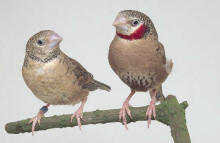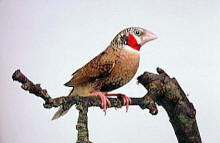|

A pair of
Cut-Throats |
BREEDS & their NEEDS
CUT-THROAT FINCH
(Amadina fasciata)
Waxbill Finch
NEEDS HEAT IN COLDER MONTHS
This
page is still under construction . . . |

Cut-Throat male |
DESCRIPTION
-
The Cut-throat or
Ribbon Finch is a rather stocky Waxbill with a sturdy beak.
-
It's plumage
is predominantly different shades of brown with a complex barred
and spotted pattern.
-
Superficially it
resembles a Mannikin (Lonchura)
-
but shares
certain traits with the Pytilias,
-
such as the
mouth markings and downy cladding of its nestlings
-
some aspects
of its voice and behaviour are similar.
-
It is 11-12 cm
(4½-4¾ in) in length
-
Females tend
to be more delicate than the males but once acclimatised, it can
be quite a long-lived bird
reaching 10years+
-
In the wild
the species may be taken for a small ‘sandy speckly’
sparrow-like bird with white tips to its
outer tail feathers.
-
However, the broad
bright red band running right across the throat, cheeks and ear
coverts is diagnostic
of the male.
-
It is extremely
sociable and the pair-bond is strong so females are unlikely to
be seen alone.
-
Fairly Hardy
but needs extra warmth in cold weather
FEATHER & BODY DESCRIPTION
-
It's Dimorphic
i.e. the sexes differ in looks therefore easy to sex once past
juvenile moult.
-
The nominate,
A. f. fasciata, is a pale sandy brown or sandy fawn
with a slight pinkish tinge
on its forehead, crown and nape with delicate crescentic
black bars across each feather.
-
The wing
coverts are a darker and more greyish brown with black
sub-terminal bars,
-
The under wing
~ pinkish fawn.
-
The central
tail feathers are brownish black, usually with very small
white spots, which soon wear off.
-
The outer tail
feathers are broadly tipped with white and the outer webs of
the outermost pair are
entirely white.
-
The upper
throat and the front of the face are creamy white.
-
A broad,
bright
dark red band
runs across the lower throat and extends up the sides of the
face
to above the ear opening.
-
Otherwise
immediately beneath the red band the upper breast is creamy
white, shading to
pinkish fawn on the breast.
-
On the lower
breast and upper part of the abdominal area there is a patch
of dull chestnut,
broadly enclosed at the front and sides by
conspicuous pale spotted plumage.
-
The flanks are
pinkish fawn, with narrow blackish fringes to the feathers
forming a delicate barred
or scaly pattern.
-
The lower
belly and ventral areas are pale fawn to whitish.
-
The under tail
coverts have extensive whitish tips backed by blackish
crescentic subterminal bars
and greyish bases.
-
The BEAK
is horny grey, pinkish grey, grey and pinkish or bluish
grey
-
The EYES
are brown, reddish or light brown.
-
The LEGS
and FEET are pale flesh-coloured.
-
In older birds the
pink tinge in the plumage disappears and the bird becomes paler
and more sandy.
-
The female
lacks the red on the throat and face
and is pale fawn,
speckled with blackish in these areas.
-
Her under-parts
are primarily pale fawn, with blackish markings on the sides of
the breast and flanks;
the blackish markings sometimes extend right across the breast.
-
The juvenile
male is almost intermediate in pattern between the male and
female
-
but the red
band is clearly noticeable though it is paler than in the
adult.
-
The tips of
its wing coverts and inner secondaries are also paler and
more sandy in tone.
-
The juvenile
female is like the adult but with paler feather tips as in
the juvenile male.
SUB-SPECIES
TEMPERATURE PREFERRED
-
25ºC (77ºF) is the
recommended temperature for new arrivals
-
and it is
important not to let the temperature drop below 15ºC (60ºF),
-
especially at
breeding time as females can be susceptible to egg-binding.
-
Higher
temperatures help to alleviate this problem.
TYPE OF TERRAIN PREFERRED IN THE WILD
-
It is found below
1500metres in arid country where it inhabits dry Acacia Savanna,
semi-desert or desert with some trees or bushes and available
surface water.
-
It is usually seen
in flocks, both large and small, or in pairs, and frequently on
bare branches perched high
in the treetops.
-
Single birds may
be seen during the breeding season while their mate is on the
nest.
-
It usually hops on
the ground but can also walk or run short distances.
-
It forages for
food on the ground, which consists primarily of grass seeds but
termites and other insects
are also eaten.
COURTSHIP DISPLAY
BREEDING AND NEST BUILDING IN THE WILD
-
Nests are built at
the end of the rainy season ~ in the dry season
-
They are sited in
trees, shrubs, bushes and occasionally in holes in trees and
buildings.
-
Weavers’ and other
species’ nests are often utilised and are used to sleep in.
-
Natural nests are
rather untidy roundish structures made out of grass stems and
similar materials
lined with feathers.
-
The nest is
sometimes constructed with a short funnel entrance.
-
Occasionally the
bird nests in colonies.
NEST BUILDING IN CAPTIVITY
-
Cutthroat finches
breed easily, and fast!
-
One of the
simplest birds to raise, and babies can be hand-trained.
-
A wooden nesting
box is recommended, and they will build the nests with many
available materials
-
yarn, twigs,
bits of cloth, grasses and feathers.
-
A good way to
get rid of old hair from hairbrushes too.
-
Opinions differ as
to the reliability of the Cut-throat’s breeding success in
captivity
-
some pairs
are nervous will abandon eggs and/or young at the
slightest intrusion
-
while others
will tolerate nest-inspection and handling of their
chicks.
-
It is far
safer to err on the side of caution and allow them plenty of
privacy and quiet.
-
Once a pair
has a proven track record of successful breedings they are
less likely to be easily disturbed.
-
Nest-boxes and
baskets
are utilised and it is important to provide various types of
coarse building materials,
-
such as hay, grass
stems and shredded paper, as well as feathers with which to line
the inside of the nest.
-
when provided with
coconut fibres or long, fine grasses, they'll weave elaborate
nests that are quite sturdy.
-
They will weave a
globular nest with a tunnel entrance in a large finch box
DIET
-
Standard finch mix (they do have a
preference for the larger millets so a parakeet mix
would be fine too),
-
Egg food,
-
Gamebird crumbles
(optional)
-
Green food
-
some Live food.
-
If kept in an
outside aviary with a dirt floor, the birds will dig in the dirt
looking for bugs.
-
Otherwise, if kept
in a cage, they will love to scatter and dig in their food dish.
-
Calcium
in the form of crushed egg shell, crushed oyster shell and
cuttlefish should always be available.
-
If using chicken
egg shells, bake in the oven until they are a slight yellow
shade,
-
grind up and feed
to them.
-
Liquid calcium
additive in the water or drizzled on their egg food while
Breeding to avoid egg-binding
-
Since they have a
high-fat diet, nutrition supplements should be used.
-
The best way is to
add vitamin drops to their water.
FAVOURITE FOODS
-
Live food (mealworms,
termites, ant pupae), millet, green food,
egg food,
some fruit (oranges, pears, apples).
HABITS
& Considerations
-
Cut-throats form strong pair bonds and are a
social species.
-
Members of a pair may engage in allopreening.
-
Outside of the breeding season, these birds live
in large flocks.
-
They enjoy "dust bathing" and may benefit from
access to a shallow dish of dry (chemical-free)
earth
-
Cut-throats have been known to investigate the
nests of less-bold species and throw out their
eggs and
young then commandeer the nest.
-
They
tend to remain peaceful towards other
cut-throats even while breeding (if a spacious
enough enclosure is provided).
-
In
a non-breeding mixed aviary, Cut-throats may be
peaceful inhabitants, but if they show signs of
aggression, they may need to be separated from
the more passive species.
-
Cut-throats are prone to induced melanism
if they are not housed adequately with plenty of
natural light.
-
To avoid this plumage
problem, make sure to provide your birds with
adequate lighting and a quality diet.
-
If
housed in small enclosures, Cut-throats have a
tendency to become lethargic and obese;
-
keeping Cut-throat finches in a spacious,
well-planted aviary is advised.
LIVEFOOD REQUIRED AT BREEDING TIME
-
Some pairs require
Livefood with which to rear their young, such as waxworms,
mealworms and spiders,
-
While others need
only dry and soaked seed, egg-food and a little green food.
-
Livefood,
therefore, should be considered essential until proven
otherwise.
-
Hens of this
species also tend to suffer from egg binding; therefore,
providing a constant source of
calcium and a balanced diet is
important, and breeding should be limited to warmer weather.
EGGS & INCUBATION
-
4-5 eggs are laid
-
Because hens are
prone to egg-binding, Cut-throats should not be bred until they
are at least 1 year of age.
-
They start laying
and breeding at different times in their native homelands but in
U.K. they start in the spring.
-
They are incubated
by both sexes in turn during the day.
-
During the night
the pair roosts together in the nest.
-
Incubation
takes 12-13 days
-
The young fledge
at 21-23 days.
-
The parents
continue to feed the parents up to about 21 days after fledging.
-
Closed Ring size
E
THEIR CALL/SONG
-
The Cut-throat
emits contact calls that resemble sparrow-like chirping and
there are also wheezier notes.
-
The nest call is
not unlike the sound made by a creaking door
-
The song has been
described as low pitched with a humming or buzzing sound
-
also as a fruity
warble which may be repeated several times without a break.
-
The female’s song
consists of low, toneless warbling sounds.
-
The male sings
both undirected song and in display and usually the feathers of
the bird’s head and
underparts are more or less erected and the head is turned from
side to side.
HOUSING
-
Cut-throats are
best housed one pair to a spacious cage or a small group to a
spacious indoor flight.
-
It is essential
that they are not housed with timid finches and waxbills,
especially during the breeding season,
as these will be bullied.
-
Birds larger than
themselves are not always immune, either.

^Top |

